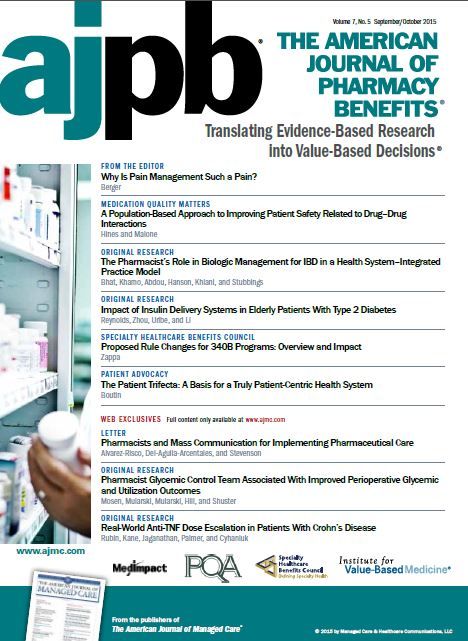Publication
Article
AJPB® Translating Evidence-Based Research Into Value-Based Decisions®
Why Is Pain Management Such a Pain?
Author(s):
The United States has a pain management problem that stems from both treatment style and misuse; input from multiple stakeholder groups will be required to find a solution.
We have a definite pain management problem in the United States, and although everyone might agree with that broad notion, not everyone necessarily agrees on where to place the blame. Some might say the problem is that we do not treat patients’ pain aggressively enough, which results in individuals unable to attain the quality of life they are capable of having without chronic discomfort. A recent Institute of Medicine report stated at least 100 million Americans have chronic pain as a result of injury or illness, and that pain is costing our country in excess of $600 billion annually.1 The American Productivity Audit also found that over half of the studied workforce reported having pain due to musculoskeletal issues such as backache and arthritis, or headaches, creating a work productivity loss of 4.6 hours per week.2 I must admit that I was a bit naive regarding the issue of pain until the last few years when, like many others my age, I began to experience back pain. I am lucky enough that I can control my pain with stretching, physical therapy, and an occasional ibuprofen, but this is often not the case for everyone.
Others might say that the pain problem in the United States is due more to inappropriate use of pain medications. This is not to say that individuals who abuse pain medications are not in pain; rather, it is saying they are either obtaining these medications through channels other than their doctor or taking the medications outside of the prescribed usage and evidence-based guidelines. The CDC has stated that prescription drug abuse is at epidemic levels.3 However, although this problem can be found across the United States, the sale and amount of overuse differs in severity based on region. In addition to the regionalization of the problem, age differences also factor in, with 2.1% of adults 50 years or older in the past year misusing prescription drugs.4 The 2 million adults in that age group serve to dispel the myth that overuse of pain medications is only found in the young.
Overall, the American College of Preventive Medicine has stated that 5.3 million people abuse pain relievers every month,5 resulting in annual direct healthcare costs of $72.5 billion for health insurers.6 Furthermore, this type of prescription abuse fuels an increase in emergency department use—and this is not a new issue—with the number of visits between 2004 and 2009 almost doubling as a consequence.6 In general, it has been shown that opioid abusers have direct healthcare costs that are 8 times higher than that of nonabusers.5
So what do we do about this dual-edged medical problem? In order to effectively address both of the problems discussed, all stakeholders will have to play a part: payers can influence the pain issues through the pharmacy benefit manager (PBM), who has a direct role in addressing the overuse and misuse of pain through their support of appropriate drug choice and utilization management tools. However, recent legislative action (ie, Ohio House Bill 248) presents a challenge to this type of PBM support. This bill requires that abuse-deterrent opioids—which are up to 10 times more expensive than the older formulations—be mandated regardless of the patient’s issue and history of misuse.7 Although this may initially seem like it would provide positive results, there is minimal, if any, definitive evidence that these medications are less likely to be misused. Further, this bill would limit health plans’ and PBMs’ ability to utilize common tools such as prior authorization and quantity limits.7
Instead, a payer may choose to consider the use of a narrow network of pharmacies for patients on pain medications, which would allow these pharmacies to focus support on the patient and to work more closely with the prescribers of these medications. The medical benefit can also have a significant effect on making sure that patients in need of pain management have adequate access to these therapies, and health plans can still tackle the abuse of pain medications by using providers with significant knowledge and experience in pain management, by requiring those that are prescribing pain medications to: 1) utilize prescription drug monitoring programs, 2) put pain contracts in place with their patients, and 3) utilize appropriate lab screening.
The United States has a pain management problem, and this problem has a marked effect on the patient, the payer, and society. It will take everyone’s involvement to find the solution to this problem, so I would love to hear from you all as to what has worked effectively in your organizations.







